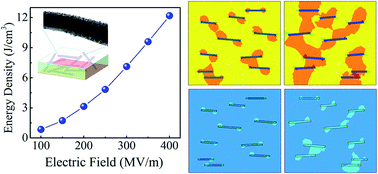Excellent energy density of polymer nanocomposites containing BaTiO3@Al2O3 nanofibers induced by moderate interfacial area†
Abstract
Inorganic/polymer nanocomposites, using one-dimensional (1D) core–shell structure BaTiO3@Al2O3 nanofibers (BT@Al2O3 nfs) as fillers and poly(vinylidene fluoride) (PVDF) as the polymer matrix, have been prepared. The core–shell structure BT@Al2O3 nfs have been synthesized via coaxial electrospinning. The breakdown strength (Eb) and discharged energy density of the nanocomposites can be significantly improved by creating an insulating Al2O3 shell layer with moderate dielectric constant on the surfaces of BT nanofibers to form a moderate interfacial area. The Al2O3 shell layer could effectively confine the mobility of charge carriers, which reduces energy loss by reducing the Maxwell–Wagner–Sillars (MWS) interfacial polarization and space charge polarization between the fillers and the polymer matrix. As a result, the nanocomposite films filled with 5 vol% BT@Al2O3 nfs exhibit a excellent discharge energy density of 12.18 J cm−3 at 400 MV m−1, which is ≈254% over bare PVDF (4.8 J cm−3 at 350 MV m−1) and ≈1015% greater than the biaxially oriented polypropylenes (BOPP) (≈1.2 J cm−3 at 640 MV m−1). The work here indicates that this promising state-of-the-art method of preparing high energy density nanocomposites can be used in the next generation of dielectric capacitors.


 Please wait while we load your content...
Please wait while we load your content...